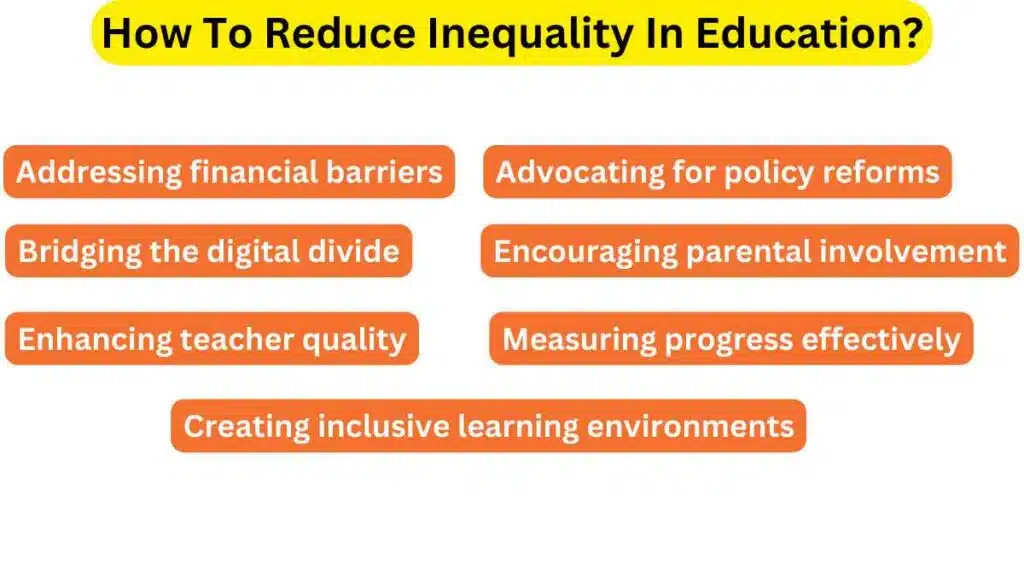How To Reduce Inequality In Education?
Reducing inequality in education is a collective responsibility that requires the combined efforts of governments, educators, communities, and individuals.
We can pave the way toward a more equitable and brighter future for generations to come by
- Addressing financial barriers
- Bridging the digital divide
- Enhancing teacher quality
- Creating inclusive learning environments
- Encouraging parental involvement
- Advocating for policy reforms
- Measuring progress effectively
What is Educational Inequality?
Educational inequality refers to the unequal distribution of educational resources and opportunities among different groups of people. This disparity can be attributed to various factors, such as economic status, geographical location, and cultural barriers.
Limited access to quality schools, lack of adequate funding, and a shortage of qualified teachers contribute to educational disparities.
The result of educational inequality is far-reaching. It continues the cycle of poverty, as individuals from disadvantaged backgrounds may not have access to the education necessary to break free from poverty.
It hampers social mobility and creates divisions within society, hindering overall progress and development.
Factors of Educational Inequality
Socioeconomic Factors
Socioeconomic status plays a crucial role in determining a person’s access to quality education. Children from low-income families often face financial barriers that prevent them from enrolling in good schools or pursuing higher education. Addressing these financial challenges is essential to reducing educational inequality.
Geographical Barriers
In many regions, access to education is hindered by geographical factors. Remote and marginalized communities may lack proper infrastructure, making it difficult for children to attend school regularly. Bridging this gap is vital to ensure equal educational opportunities for all.
How To Reduce Inequality In Education?

Addressing Financial Barriers
Scholarships and Grants
Offering scholarships and grants to students from disadvantaged backgrounds can significantly impact their access to education. Educational institutions and governments should collaborate to create scholarship programs that cater to the needs of economically challenged students.
Financial Aid Programs
Implementing financial aid programs can alleviate the burden of educational expenses for deserving students. These programs can cover tuition fees, provide support for educational materials, and help students manage their living costs during their academic journey.
Bridging the Digital Divide
Equitable Access to Technology
In the digital age access to technology is crucial for students to thrive in their educational pursuits. Providing equal access to computers, tablets, and the internet can empower students from all backgrounds to explore new learning opportunities.
E-Learning Initiatives
Integrating e-learning initiatives into the education system can enhance accessibility and flexibility. Online courses and digital learning platforms enable students to learn at their own pace, breaking down barriers posed by traditional classroom settings.
Enhancing Teacher Quality
Professional Development
Investing in the professional development of teachers is vital for improving the quality of education. Continuous training and workshops can equip educators with the latest teaching methodologies and ensure they cater to the diverse needs of their students.
Incentives for Teachers
Offering incentives and rewards to teachers who work in underprivileged areas can encourage skilled educators to contribute their expertise to the communities that need them the most.
Creating Inclusive Learning Environments
Diverse Curriculum
Designing a diverse and inclusive curriculum can promote a broader understanding of various cultures and perspectives. Inclusive education fosters empathy and understanding among students, fostering a harmonious learning environment.
Support for Students with Special Needs
Ensuring that students with special needs receive adequate support and accommodations is crucial for inclusivity. Special education programs and accessible learning materials can enable these students to participate fully in the educational process.
Encouraging Parental Involvement
Community Engagement
Engaging with local communities and parents is essential for understanding their needs and concerns regarding education. Building strong partnerships between schools and families can create a support system for students.
Parent-Teacher Collaboration
Encouraging regular communication between parents and teachers can foster a supportive learning environment. When parents are actively involved in their children’s education, students tend to perform better academically.
Advocating Policy Reforms
Government Initiatives
Governments play a pivotal role in shaping educational policies. Advocating for policy reforms that prioritize reducing educational inequality can drive positive change across the education system.
Stakeholder Cooperation
Collaboration among various stakeholders, including governments, educational institutions, and non-governmental organizations is essential for the effective implementation of education-focused initiatives.
Measuring Progress and Impact
Data Collection and Analysis
Regularly collecting and analyzing data related to educational outcomes can provide insights into the effectiveness of initiatives aimed at reducing inequality. Data-driven decision-making can lead to targeted interventions for better results.
Continuous Improvement Strategies
Adopting a continuous improvement approach allows educational institutions to refine their strategies over time. By learning from successes and failures, the education system can become more responsive to the needs of students.



Leave a Reply